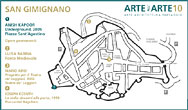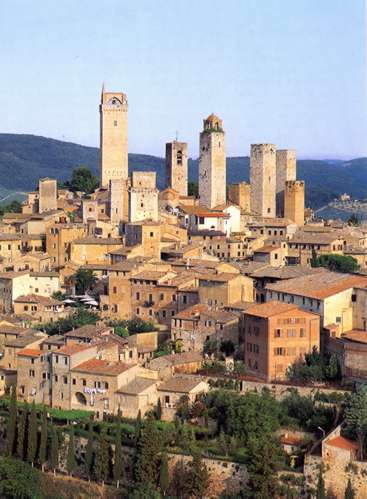 |
Developed
between the 9th and the 12th century, at the junction of the oldest path
of the via Francigena and of the via Pisana leading towards the sea, the
town (324 m) soon became home of a flourishing market and was embellished
by beautiful palaces and by the famous towers, symbols of the wealth of
the mercantile class. When the
town was at its highest peak the towers amounted to 72, all protected
since the year 1272 by a law forbidding the demolition of old houses,
with the exception of those demolitions made in order to rebuild other
house more beautiful than the old ones. The growing importance of the
new path via Francigena at the bottom of the valley determined the economic
decadence, and the subsequent stagnation of San Gimignano lasted until
the 19th century. Within the city wall surrounding the inhabited city
is the charming city centre, with palaces and squares with a grace and
beauty which go beyond time. Definitely
worthwhile to visit is the Romanic church (12th century) dedicated to
S. Maria Assunta, extended in the 1460 on a project by Giuliano da Maiano,
which still retains frescos by Taddeo di Bartolo (1393) and Benozzo Gozzoli
(1465), wooden statues by Jacopo della Quercia, painted by Martino di
Bartolomeo, and the frescos cycle of the New Testament by Lippo and Federico
Memmi, from the second half of the 14th century, followed by the contemporaneous
Old Testament, by Bartolo di Fredi.
|
|

|
| |
 |
|
In the chapel
of S. Fina, one of the most significant works of Tuscan Renaissance realised
by Giuliano and Benedetto da Maiano, frescos by Domenico del Ghirlandaio
and of his scholar Sebastiano Mainardi (1475), and a back piece by Benedetto
da Maiano (1475). Through an arch on the left side we enter the Piazza
dè Pecori , where we can find the Museum of Sacred Art, with the Madonna
della Rosa by Bartolo Fredi, the sculptures by the Da Maiano and the polychrome
wooden statues from 13th century.
From the
courtyard of Palazzo del Popolo (built in 1288 and extended in 1323) displaying
frescos by Sodoma and a well of 1361, we gain access to the civic museum
with its grand Maestà (1317), a fresco by Lippo Memmi, and other works
of the Tuscan school: Pinturicchio, Coppo di Marcovaldo, Benozzo Gozzoli,
Flippino Lippi, Memmo di Filippuccio e Taddeo di Bartolo. In the mayor's
room we can admire the series of paintings by Memmo di Filippuccio with
scenes of married life.
Close by
the Porta San Matteo (1261) we find S. Augustino church, built in Romanic-Gothic
style during the years going from 1280 to 1298, which contains the masterpiece
by Piero del Pollaiolo, the Incoronazione di Maria e i Santi Nicola da
Bari, Agostino, Gimignano, Niccolò da Tolentino e Girolamo (1483), and
the grandiose series of frescos on the life of S. Augustine by Benozzo
Gozzoli and his school.
|
| |
In the close-by Via Folgore, you will find the new museum centre, located
in the ex-convent of S. Chiara and in the Leopoldian convent school, the
archaeological museum (with Etruscan and Roman finds coming from tombs discovered
in the area), the spice warehouse of S. Fina (collection of vases and pottery
from the old hospital of S. Fina) and the Modern Art Gallery (from the Macchiaioli
to our days). From the Porta alle Fonti, we can walk down to the fonts,
with its series of 10 curved arches built between the 12th and the 14th
century and restored in the 1852. |
|
|

